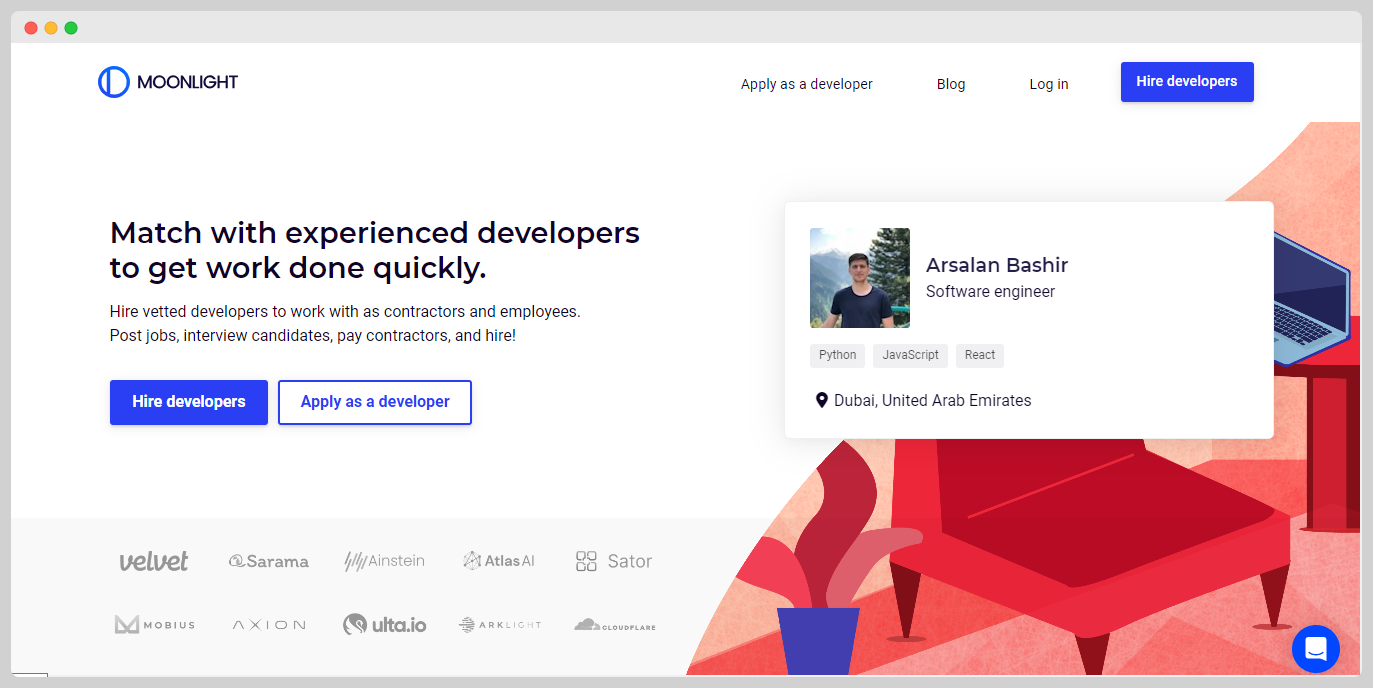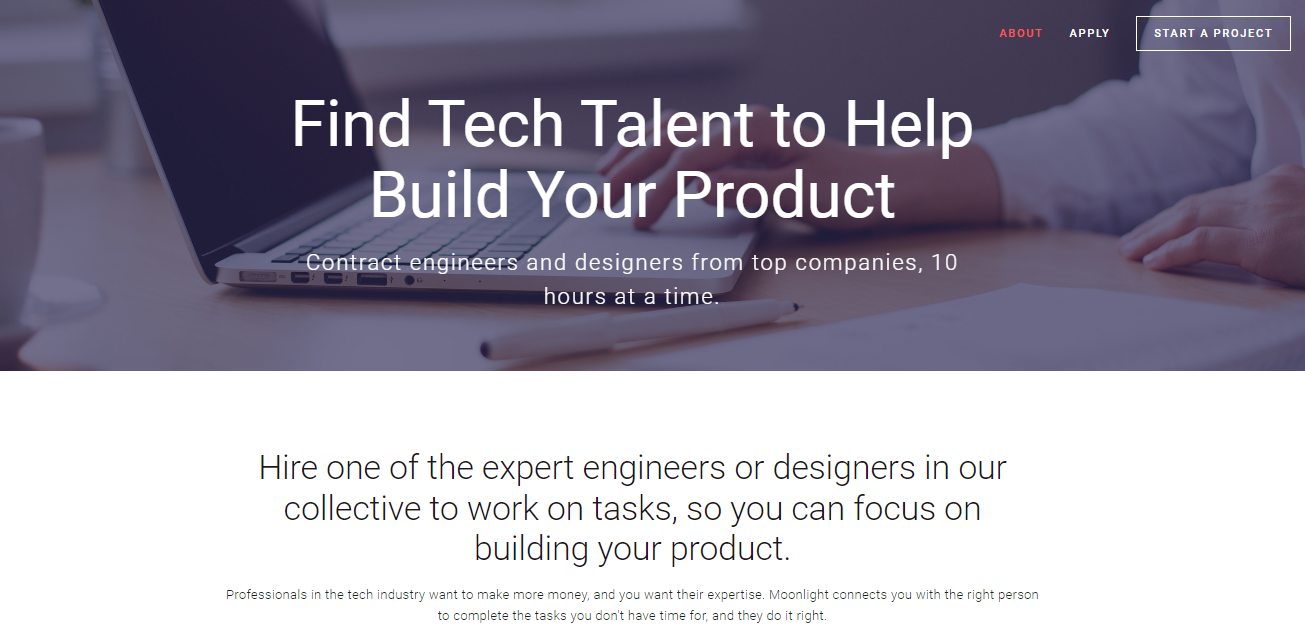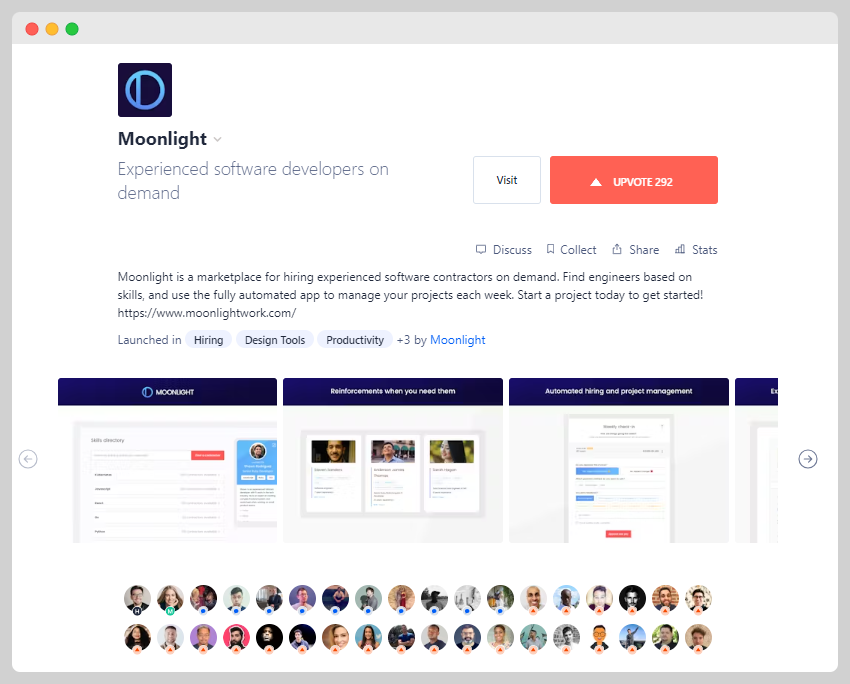How These Founders Quadrupled Revenue With a Developer Hiring Platform
Who is Philip Thomas?
Emma Lawler, a product designer with experience at startups like Fitbit, and Philip Thomas, a software engineer formerly behind Staffjoy, co-founded Moonlight as digital nomads from San Francisco, aiming to blend remote work with high-quality job opportunities.
What problem does Moonlight solve?
Moonlight solves the painful problem of finding reliable, high-quality remote software developers by providing companies with a vetted, subscription-based community, ensuring dependable hiring and reduced recruitment overhead.

How did Philip come up with the idea for Moonlight?
Emma and Philip came up with the idea for Moonlight during their stint as digital nomads, where they experienced firsthand the difficulty of finding high-skill contract work outside their personal networks. This challenge was pivotal, as it highlighted a gap in the market for a platform that could connect skilled developers with companies looking for part-time remote talent.
Before diving into development, they validated their idea by creating a simple landing page on Squarespace with a Typeform, and they emailed 1,000 software developers to gauge interest. The high conversion rate from these initial outreach efforts confirmed that other freelancers faced the same problem, which assured them that their idea had merit.
To refine their concept, they started by manually matching developers with companies using tools like Zapier, Google Sheets, and email. The success of these manual processes helped them gather valuable feedback, which they used to iterate on their product before committing to more extensive development. This approach not only minimized risk but also allowed them to build a solution that was closely aligned with user needs.
How did Philip build the initial version of Moonlight?
Emma Lawler and Philip Thomas initially built Moonlight's MVP using a no-code approach to validate their hypothesis without writing a line of code. They used Squarespace for the landing page, Typeform for sign-ups, and Zapier for automations, processing their first $50K in transactions manually. They managed contracts, timesheets, invoicing, and payments using Google Drive, Mailchimp, TransferWise, and other similar tools. After they validated the concept, they began automating the process, integrating tools like Stripe Connect for payments and Vue.js for the web application. It took them approximately nine months from idea to automation, launching their first product iteration in March 2018. This manual-to-automated approach allowed them to stay lean and adaptable while building an MVP that directly responded to user needs.

What were the initial startup costs for Moonlight?
- Domain and Landing Page: They spent approximately $50 per month on a Squarespace page combined with Typeform for initial testing.
- Business Incorporation: They spent $500 to incorporate the business through Stripe Atlas.
- Tools for Manual Operations: Initial tools such as Zapier, email, and Typeform were used for a no-code prototype using mostly free or low-cost software.
- Community and Marketing: Investment in community-building through meetups and a newsletter, though specific costs for these efforts weren't detailed.
How did Philip launch Moonlight and get initial traction?
Cold Email Outreach
Philip and Emma started Moonlight by emailing 1,000 software developers to join the platform for short software projects. They used a simple Typeform linked to a Squarespace landing page to collect sign-ups.
Why it worked: Cold emailing allowed them to target their ideal user base directly and get immediate feedback. The high conversion rate (18% sign-up rate) validated their idea early on and led to their first paying customers quickly.
Metrics:
- Sent 1,000 cold emails
- Achieved an 18% conversion rate
- Resulted in initial sign-ups which were crucial for the marketplace to take off
Product Hunt Launch
In March 2018, Philip and Emma launched Moonlight on Product Hunt. This platform allowed them to reach a tech-savvy audience and generated interest and sign-ups from both developers and companies.

Why it worked: Product Hunt is known for its active community of early adopters and tech enthusiasts. The exposure from being featured on Product Hunt provided Moonlight with significant visibility and credibility.
Metrics:
- Boosted sign-ups significantly on the launch day
- Generated considerable traffic and engagement
- Created a surge of new user registrations and projects posted
Weekly Newsletter
Moonlight used a weekly newsletter to keep both developers and hiring managers engaged. Each newsletter included personal intros and algorithmically generated job matches and updates.
Why it worked: Regular communication kept the existing user base engaged and informed, leading to higher retention and repeat usage. Introducing personalized job matches made the content highly relevant and useful.
Metrics:
- Sent a newsletter every Tuesday
- Personalized content led to increased engagement from both developers and hiring managers
- Contributed to a 79% increase in user engagement after launching the membership model
Community Meetups
While living as digital nomads, Philip and Emma hosted weekly meetups for tech workers in various cities. These meetups helped build a sense of community among their users and attracted new developers to join Moonlight.
Why it worked: The personal touch of in-person meetings and community building was memorable for participants. It created a more substantial connection with the brand and helped spread word-of-mouth recommendations.
Metrics:
- Hosted meetups in multiple cities globally
- Resulted in a consistent influx of new developer sign-ups
- Enhanced community loyalty and long-term engagement
These initial strategies helped Moonlight not only get their first customers but also lay the groundwork for a sustainable and engaged user base.
What was the growth strategy for Moonlight and how did they scale?
Product Hunt
Moonlight saw significant traffic and user engagement through Product Hunt. Their initial launch on the platform in March 2018 brought in the most sign-ups they had experienced in a single day. They continued to use Product Hunt for additional product updates and leveraged its Ship feature to plan ahead and keep the community engaged.
Why it worked: Product Hunt is frequented by developers and tech enthusiasts, making it a perfect match for Moonlight’s target audience. The platform's community-driven nature allowed them to reach a large, relevant audience quickly. Frequent launches kept them visible and engaged with their core users.
Email Marketing
Email marketing was a cornerstone of Moonlight's growth strategy. They sent out a weekly newsletter every Tuesday to both developers and hiring managers. This newsletter included personalized introductions, algorithmically generated matches, and updates specific to each user group. They also launched the Broadcasts feature, which sent alerts to companies about developers actively looking for work.
Why it worked: Regular, tailored communication kept users engaged and informed. The newsletters and alerts provided consistent value, helping to maintain a strong connection with their community and ensuring that users regularly interacted with the platform.
Marketplaces and Forums (Hacker News)
In addition to Product Hunt, Moonlight utilized Hacker News and other relevant online forums. These platforms were integral for initial user acquisition and subsequent engagement.
Why it worked: These forums are popular among tech professionals, providing a direct line to their target audience. Sharing updates and engaging in conversations on these platforms helped Moonlight attract early adopters and maintain ongoing interest.
Referral Program
Moonlight implemented a referral program that rewarded users for referring new clients and developers. This included monetary incentives and branded swag for successful referrals.
Why it worked: Word-of-mouth and personal recommendations are powerful growth drivers. The referral program not only helped attract new users but also kept existing users motivated to bring others into the community, fostering organic growth and long-term user retention.
What's the pricing strategy for Moonlight?
Moonlight charges companies $100/month or $1,000/year for unlimited access to developer matches and tools, while remaining free for developers.
What were the biggest lessons learned from building Moonlight?
- Listen to Your Customers: Initially, Moonlight tried to control how companies worked with contractors, but pivoted to a more open, membership-based model after understanding their needs. Direct feedback can steer you to a more successful path.
- Manual First, Automate Later: They started with a completely manual process to validate their business before building any code. This saved time and ensured they were developing something valuable.
- Adapt Quickly: The transition from per-transaction fees to a subscription model significantly boosted their revenue and engagement. Flexibility in your business model can lead to unexpected growth opportunities.
- Network and Community Engagement: Hosting tech meetups and frequent public launches on platforms like Product Hunt helped them grow their user base. Building community can enhance user engagement and loyalty.
- Remote Work Advantages: Embracing a remote lifestyle allowed them to attract global talent and maintain flexibility. If done right, remote work can be a powerful asset for scaling a business.
Moonlight Acquisition: How much did Moonlight sell for and what was the acquisition price?
Moonlight was acquired by PullRequest in March 2020 for an undisclosed amount. The acquisition aimed to enhance PullRequest's code review services and train machine learning tools to fix common coding errors.
Discover Similar Business Ideas Like Moonlight
Data science recruitment company Big Cloud shares how they grew their business to generate £250k per month through expanding into global markets and using social media and marketing strategies to attract and retain customers while keeping a strong focus on building honest, long-standing relationships with clients and candidates.
Social entrepreneur founder turned 7-figure business owner builds highly educated and dedicated virtual assistants agency, Outsourcing Angel, which hires for hundreds of clients worldwide by finding, recruiting, and working with clients and virtual assistants every step of the way while donating 10% of profits to fund charity initiatives to help poverty-stricken areas.
More about Moonlight:
Who is the owner of Moonlight?
Philip Thomas is the founder of Moonlight.
When did Philip Thomas start Moonlight?
2017
What is Philip Thomas's net worth?
Philip Thomas's business makes an average of $65K/month.
How much money has Philip Thomas made from Moonlight?
Philip Thomas started the business in 2017, and currently makes an average of $780K/year.

Download the report and join our email newsletter packed with business ideas and money-making opportunities, backed by real-life case studies.

Download the report and join our email newsletter packed with business ideas and money-making opportunities, backed by real-life case studies.

Download the report and join our email newsletter packed with business ideas and money-making opportunities, backed by real-life case studies.

Download the report and join our email newsletter packed with business ideas and money-making opportunities, backed by real-life case studies.

Download the report and join our email newsletter packed with business ideas and money-making opportunities, backed by real-life case studies.

Download the report and join our email newsletter packed with business ideas and money-making opportunities, backed by real-life case studies.

Download the report and join our email newsletter packed with business ideas and money-making opportunities, backed by real-life case studies.

Download the report and join our email newsletter packed with business ideas and money-making opportunities, backed by real-life case studies.

